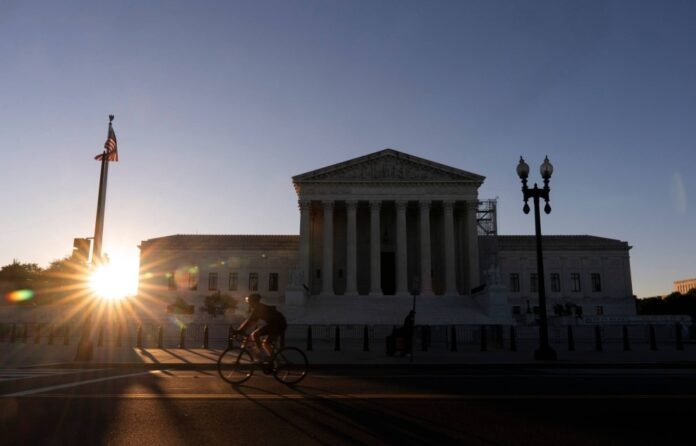The U.S. Supreme Court has just struck down a long-standing legal principle that gives federal agencies the power to interpret and implement laws. Friday’s ruling will weaken the government’s hand in setting environmental policy and could erode existing protections for the climate, air and water.
And if former President Donald Trump wins back the White House in November, it will give him the power to roll back his predecessor’s climate rules.
“This gives industry the opportunity to challenge anything an agency does and drag it through the courts for years,” said Doug Kysar, a professor of environmental law at Yale University.
A victorious Trump would “certainly rely on” the decision in Loper Bright Enterprises v. Raimondo to undo President Joe Biden’s rules, said Jeff Holmstead, a former assistant administrator of the Environmental Protection Agency under George W. Bush and now a partner at Bracewell LLP. “It’s obviously going to make it harder for a future administration to come back and try to fix it.”
A Trump administration could also lean on the ruling to spur oil and gas development, said Kathleen Sgamma, president of the Western Energy Alliance, an energy trade group. “I think the regulatory rollback will happen more quickly,” she said.
Runner Bright ended what had become known as the Chevron deference, a legal doctrine that held that courts must defer to the technical expertise of agency staff when interpreting ambiguous statutes. As an example of the reasoning behind this, Justice Elena Kagan noted in a dissent that scientists at the U.S. Fish and Wildlife Service are much better at distinguishing rare squirrels from common squirrels than judges are at distinguishing them as endangered.
“I don’t think anyone, looking at the Supreme Court or justices in general, would say they’re squirrel experts, right?” asked Andrew Mergen, faculty director of the environmental law clinic at Harvard Law School and a former environmental lawyer at the Justice Department. “The idea is that the question of ‘squirrelness’ should be left to people who are experts in wildlife biology and zoology.”
At first glance, the ruling is politically neutral: All executive branch agencies, whether they operate under a Republican or Democratic president, now have less latitude. But environmental groups and legal scholars say it will spur deregulation.
“The net effect will be to weaken our government’s ability to address the real problems the world presents to us,” said David Doniger, a senior strategic director at the Natural Resources Defense Council.
“It’s not a neutral sword,” Kysar said. “It’s a sword that can wield one side with much more destructive power than the other,” since industry has deeper pockets than environmental groups.
Trump’s judges, who were selected largely on the basis of their conservative credentials and are being confirmed at a record pace, are likely to face many challenges.
Two Biden-era rules that are particularly vulnerable to repeal are EPA rules limiting greenhouse gas emissions from power plants and vehicle exhaust.
Trump has already made clear that he plans to repeal both measures, but Loper Bright adds another legal justification for the shift. Any regulations that didn’t make it all the way to the Supreme Court — including these measures — “could, with a very reasonable argument, be tossed out and reexamined,” said former Environmental Protection Agency administrator Andrew Wheeler, now a partner at Holland and Hart LLP.
Trump has promised to greenlight hundreds of new power plants and repeal Biden’s rule. He has also promised to end what he calls Biden’s “mandate” for electric vehicles, referring to strict pollution limits that force automakers to sell mostly electric vehicles and hybrids by 2032.
For years, the EPA has given automakers flexibility to meet tailpipe standards by allowing them to do so on an average basis, across their entire fleets. But while vehicle pollution limits are rooted in the Clean Air Act, that fleet-wide average approach is not specified in the law’s text.
“We don’t see anything in the statute that gives them that authority,” said Devin Watkins, an attorney with the conservative Competitive Enterprise Institute, which is challenging the regulations. That could be a greater legal vulnerability now that the Chevron stay has been dropped.
Chevron’s reversal follows the Supreme Court’s weakening of clean water protections last year. In Sackett v. EPA, the court ruled that streams that flow only when they are filled with rain are not protected by the Clean Water Act. A scientific study released last week found that about 55 percent of the water flowing out of U.S. estuaries comes from these so-called ephemeral streams.
Loper Bright’s potential impact grew even bigger when a separate Supreme Court ruling on Monday effectively wiped out the agency’s six-year statute of limitations for challenging existing rules. Now, simply forming new businesses affected by old regulations is enough to start that six-year clock.
Environmentalists vow to fight to defend Biden’s rules. And with storms, heat domes and other impacts of global warming worsening, pressure will mount on Congress to act, said Sam Sankar, Earthjustice’s senior vice president of programs.
“Yes, it makes it harder for agencies to use old laws to address new problems,” he said. “But that doesn’t mean we can’t address the threats posed by climate, and we will. The problems are getting so bad that Congress — even the right wing — is going to have to start responding in federal legislation.”



